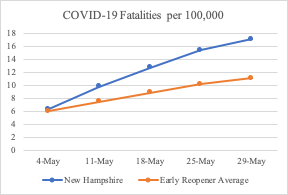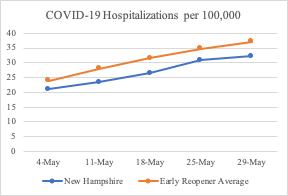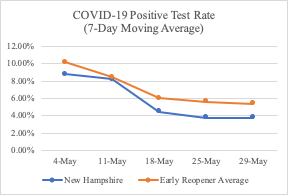Has Gov. Chris Sununu’s lingering lockdown of New Hampshire’s businesses prevented more COVID-19 deaths than states who pursued an early-reopen strategy? Not according to the latest available data.
An analysis of COVID-19 public health department records reveals 21 states that relaxed stay-at-home orders weeks ago have had lower fatality rates than New Hampshire, where Gov. Sununu’s Stay-At-Home 2.0 order remains in place. Other states have had both more economic activity and fewer coronavirus deaths than the Granite State since loosening their lockdowns on or before May 4.
Those states are Arkansas, Colorado, Florida, Georgia, Idaho, Indiana, Iowa, Kansas, Mississippi, Missouri, Montana, Nebraska, North Dakota, Ohio, Oklahoma, South Carolina, South Dakota, Tennessee, Texas, Utah, and Wyoming.
The data, collected by the COVID Tracking Project, show that from May 4 to May 29, New Hampshire saw a more substantial percentage increase in COVID-19 fatalities per capita than 19 of the 21 states that allowed businesses to begin reopening. New Hampshire’s fatalities per 100,000 rose 170 percent, while the average across early reopeners rose 87.8 percent.

At a May 29 press conference, Sununu told NHJournal that such comparisons are unfair because “the Northeast of the United States right now is Ground Zero for COVID in the world.”
“If you want to compare New Hampshire to North Dakota or something like that, places that are just naturally more rural, well, of course, their numbers are going to be lower,” Sununu said.
However, both Maine and Vermont have given citizens and businesses more freedom than New Hampshire while experiencing lower per capita fatalities. New Hampshire has suffered 18 deaths per 100,000 population, significantly higher than Vermont (9) and Maine (7).

Sununu says the metrics he’s using for reopening are rates of hospitalization and rates of new positive tests. Interestingly, on both of those metrics, New Hampshire is already performing as well or better than these 21 states, a fact that has Granite State business owners asking why they are still under the more stringent lockdown orders.
Over the same period in May, for example, New Hampshire COVID-19 hospitalizations per capita rose by a greater proportion than 9 of the 15 early reopeners for which the COVID Tracking Project has data.
New Hampshire’s positive test rate, taken as a 7-day moving average, fell by a higher percentage than 13 of the 19 early reopeners with reliable data.
On May 4, New Hampshire’s numbers for each statistic were nearly equivalent to the average across the 21 states that began reopening by that date.

The WHO recommends governments achieve a 7-day moving average positive test rate at or below 5 percent for 14 consecutive days before reopening. New Hampshire reached the 14-day mark Saturday.
ABC News analyzed data from the same states and observed “no major increase” in any of the three metrics. The states have loosened restrictions to varying degrees, but commonalities include ending stay-at-home orders and allowing nonessential businesses to reopen.
And while New Hampshire allowed some businesses to reopen at limited capacity beginning May 11, Gov. Chris Sununu announced Friday he is extending his stay-at-home order to June 15. This despite the fact that Granite State data show no spike in infection rates or hospitalizations in the wake of the new Stay-At-Home 2.0 approach.
On the whole, data suggest New Hampshire has not saved more lives or significantly outperformed other states in reducing hospitalizations, despite the state’s ongoing stay-at-home order.
Meanwhile, New Hampshire’s economic situation is bleak. As of the latest data, Granite Staters had made 197,601 jobless claims since mid-March, the second-highest increase in the unemployment rate in the country over that period.
When states began reopening in early May, there was no way to know whether it was the right decision. Now, the data are out, and NHJournal’s analysis suggested that New Hampshire’s ongoing stay-at-home order is doing little to prevent a surge in COVID-19 hospitalizations and deaths.

